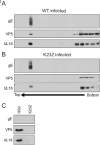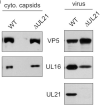Complex mechanisms for the packaging of the UL16 tegument protein into herpes simplex virus
- PMID: 20051283
- PMCID: PMC2824050
- DOI: 10.1016/j.virol.2009.12.004
Complex mechanisms for the packaging of the UL16 tegument protein into herpes simplex virus
Abstract
The conserved UL16 tegument protein of herpes simplex virus exhibits dynamic capsid-binding properties with a release mechanism that is triggered during initial virus attachment events. In an effort to understand the capsid association and subsequent release of UL16, we sought to define the mechanism by which this protein is packaged into virions. The data presented here support a model for the addition of some UL16 to capsids prior to their arrival at the TGN. UL16 was found on capsids isolated from cells infected with viruses lacking UL36, UL37 or gE/gD, which are defective for budding and accumulate non-enveloped capsids in the cytoplasm. Additionally, membrane-flotation experiments showed that UL16 co-purified with cytoplasmic capsids that are not associated with membranes. Moreover, the amount of UL16 packaged into extracellular particles was severely reduced in the absence of two conserved binding partners, UL21 or UL11.
Copyright 2009 Elsevier Inc. All rights reserved.
Figures





Similar articles
-
Interaction domains of the UL16 and UL21 tegument proteins of herpes simplex virus.J Virol. 2010 Mar;84(6):2963-71. doi: 10.1128/JVI.02015-09. Epub 2009 Dec 30. J Virol. 2010. PMID: 20042500 Free PMC article.
-
Characterization of the Herpes Simplex Virus (HSV) Tegument Proteins That Bind to gE/gI and US9, Which Promote Assembly of HSV and Transport into Neuronal Axons.J Virol. 2020 Nov 9;94(23):e01113-20. doi: 10.1128/JVI.01113-20. Print 2020 Nov 9. J Virol. 2020. PMID: 32938770 Free PMC article.
-
The Product of the Herpes Simplex Virus 2 UL16 Gene Is Critical for the Egress of Capsids from the Nuclei of Infected Cells.J Virol. 2017 Apr 28;91(10):e00350-17. doi: 10.1128/JVI.00350-17. Print 2017 May 15. J Virol. 2017. PMID: 28275195 Free PMC article.
-
Involvement of Terminase Complex in Herpes Simplex Virus Mature Virion Egress.Curr Protein Pept Sci. 2022;23(2):105-113. doi: 10.2174/1389203723666220217144432. Curr Protein Pept Sci. 2022. PMID: 35176987 Review.
-
Virus Assembly and Egress of HSV.Adv Exp Med Biol. 2018;1045:23-44. doi: 10.1007/978-981-10-7230-7_2. Adv Exp Med Biol. 2018. PMID: 29896661 Review.
Cited by
-
The Herpes Simplex Virus pUL16 and pUL21 Proteins Prevent Capsids from Docking at Nuclear Pore Complexes.PLoS Pathog. 2023 Dec 1;19(12):e1011832. doi: 10.1371/journal.ppat.1011832. eCollection 2023 Dec. PLoS Pathog. 2023. PMID: 38039340 Free PMC article.
-
Varicella-zoster virus ORF49 functions in the efficient production of progeny virus through its interaction with essential tegument protein ORF44.J Virol. 2014 Jan;88(1):188-201. doi: 10.1128/JVI.02245-13. Epub 2013 Oct 23. J Virol. 2014. PMID: 24155375 Free PMC article.
-
Role of tegument proteins in herpesvirus assembly and egress.Protein Cell. 2010 Nov;1(11):987-98. doi: 10.1007/s13238-010-0120-0. Epub 2010 Dec 10. Protein Cell. 2010. PMID: 21153516 Free PMC article. Review.
-
Assembly and Egress of an Alphaherpesvirus Clockwork.Adv Anat Embryol Cell Biol. 2017;223:171-193. doi: 10.1007/978-3-319-53168-7_8. Adv Anat Embryol Cell Biol. 2017. PMID: 28528444 Free PMC article. Review.
-
Function of glycoprotein E of herpes simplex virus requires coordinated assembly of three tegument proteins on its cytoplasmic tail.Proc Natl Acad Sci U S A. 2012 Nov 27;109(48):19798-803. doi: 10.1073/pnas.1212900109. Epub 2012 Nov 12. Proc Natl Acad Sci U S A. 2012. PMID: 23150560 Free PMC article.
References
Publication types
MeSH terms
Substances
Grants and funding
LinkOut - more resources
Full Text Sources
Miscellaneous

